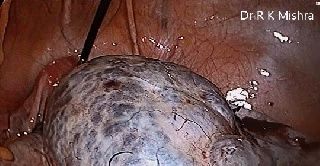This disease is mostly a result of an appendiceal primary cancer or cancer in the appendix, mucinous tumors from the ovary are also implicated, although generally ovarian involvement is favored to be a metastasis from an appendiceal and other gastrointestinal source. There is certainly substantial debate regarding histopathologic classification of pseudomyxoma peritonei. Many gynecologist proposed separating pseudomyxoma peritonei cases into two diagnostic categories: 1. Adenoma, disseminated peritoneal adenomucinosis, 2. DPAM or carcinoma peritoneal mucinous carcinomatosis, PMCA having a third category available to cases with intermediate features. With this classification system, installments of DPAM were seen as a peritoneal lesions made up of abundant extra cellular mucin containing scant all to easy to focally proliferative mucinous epithelium with little cytologic atypia or mitotic activity if we put it differently, most cells looked fairly normal high was not evidence mitosis which would indicate that cells were rapidly dividing, with or without a connected appendiceal mucinous adenoma.
Laparoscopic ovarian cystectomy is a common surgical procedure used to remove ovarian cysts that may be causing pain, discomfort or fertility issues. While this procedure is generally safe, there is a risk of complications, such as pseudomyxoma peritonei (PMP), a rare condition that occurs when mucinous tumors rupture and spill into the abdominal cavity. This essay will explore the risk of PMP after rupturing a huge laparoscopic ovarian cyst, the symptoms of PMP, the diagnosis of PMP, and treatment options for PMP.
The Risk of Pseudomyxoma Peritonei:
Pseudomyxoma peritonei is a rare condition that occurs when mucinous tumors rupture and spill into the abdominal cavity. The risk of PMP after rupturing a huge laparoscopic ovarian cyst is low, but it is still a possibility. The risk of PMP is highest when the cyst is large and complex, and when the cyst wall is thin and fragile.
The risk of PMP can also increase if the cyst ruptures during surgery. If the cyst ruptures during surgery, the mucinous material can spill into the abdominal cavity, potentially leading to the development of PMP. The risk of PMP is also higher in women who have a family history of ovarian cancer or who have a history of ovarian cancer themselves.
Symptoms of Pseudomyxoma Peritonei:
The symptoms of PMP can vary depending on the extent and location of the tumors in the abdomen. In some cases, PMP may not cause any symptoms at all, while in others, it can cause abdominal pain, bloating, nausea, vomiting, weight loss, and fatigue. As the tumors grow, they can also put pressure on nearby organs, causing additional symptoms such as constipation or difficulty urinating.
Diagnosis of Pseudomyxoma Peritonei:
Diagnosing PMP can be challenging because the symptoms can be non-specific and similar to other conditions. Doctors will typically start by performing a physical examination and ordering imaging tests such as an ultrasound, CT scan or MRI. These tests can help identify the presence of tumors in the abdomen.
To confirm a diagnosis of PMP, doctors may also perform a biopsy. During a biopsy, a small sample of tissue is removed from the abdomen and examined under a microscope to determine if it is cancerous. If the biopsy confirms the presence of PMP, additional tests may be ordered to determine the extent of the tumors and to plan for treatment.
Treatment Options for Pseudomyxoma Peritonei:
The treatment of PMP can be complex and typically involves a combination of surgery and chemotherapy. The goal of treatment is to remove as much of the tumors as possible and to prevent them from spreading.
Surgery is typically the first step in treating PMP. During surgery, the tumors in the abdomen are removed. In some cases, the entire peritoneum may need to be removed as well. This is called a peritonectomy. Surgery can be a complex and challenging procedure, and it is important to choose a surgeon who has experience treating PMP.
After surgery, patients may receive chemotherapy to help kill any remaining cancer cells. Chemotherapy can be administered intravenously or directly into the abdominal cavity.
In addition to PMP, there are other potential complications associated with laparoscopic ovarian cystectomy. These can include infection, bleeding, and damage to nearby organs. Women should discuss these risks with their doctor prior to undergoing the procedure.
It is also important for women to understand the importance of follow-up care after laparoscopic ovarian cystectomy. Regular check-ups with a gynecologist can help detect any potential complications early and allow for prompt treatment.
In conclusion, while the risk of PMP after rupturing a huge laparoscopic ovarian cyst is low, it is still a possibility. Women should be aware of the symptoms of PMP and seek medical attention if they experience any unusual symptoms after the procedure. With prompt diagnosis and treatment, the outlook for women with PMP can be positive, and it is possible to achieve a full recovery.
